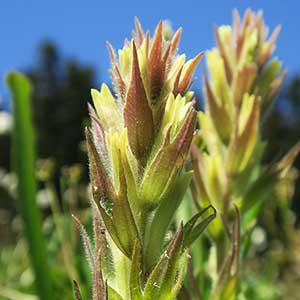Castilleja miniata
Castilleja cryptantha
common paintbrush, common red paintbrush, giant red Indian paintbrush, great red paintbrush, scarlet Indian paintbrush, scarlet or common or giant red paintbrush, scarlet paintbrush
Mt. Rainier or obscure paintbrush, obscure Indian paintbrush, obscure paintbrush
few to many, erect to ascending, rarely proximally decumbent or creeping and rooting at nodes, usually branched, glabrous, glabrate, or hairy, hairs spreading to ± retrorse, short to long, soft to stiff, rarely stipitate-glandular.
few to several, erect or ascending, unbranched, hairs spreading, long, soft, eglandular, mixed with short stipitate-glandular ones.
green to purple, linear to lanceolate, narrowly elliptic, narrowly oblong, or ovate, (1.5–)3–8(–9.5) cm, thin and not fleshy or slightly to moderately thickened and slightly fleshy, margins plane, rarely wavy, flat to involute, whole leaf sometimes recurved downward, 0(–5)-lobed, apex acute to obtuse, sometimes rounded;
lobes ascending-spreading, narrowly lanceolate, apex acute.
green, often with brown or purple veins, narrowly to broadly lanceolate, 1.5–4 cm, not fleshy, margins plane, ± involute, 0–3-lobed, apex acute to acuminate;
lobes spreading-ascending, narrowly lanceolate, apex acute to ± obtuse.
3–15(–22) × 1.5–5.5 cm, often bearing a thin, white, powdery exudate, especially on bract surfaces;
bracts greenish, scarlet, red, red-orange, or pale orange throughout, sometimes pink, magenta, pink-purple, yellow, greenish yellow, white, or salmon throughout, or proximally greenish, distally colored as above, lanceolate to oblong-ovate, 0–5(–7)-lobed, central lobes sometimes distally apiculate;
lobes erect, linear to lanceolate, oblong, or oblanceolate, short or medium length, arising near or above mid length, central lobe apex obtuse, rounded, or truncate, lateral ones rounded to acute or acuminate.
(2.5–)3–6 × 1–2 cm; green to dull brown or dull reddish purple throughout, or proximally green to dull brown or dull reddish purple, distally yellow on apices, broadly lanceolate to ovate, (0–)3-lobed;
lobes ascending, narrowly lanceolate, long or short, arising near mid length, apex acute or acuminate.
0–5 mm.
slightly curved, 20–48 mm;
tube 12–26 mm;
abaxial lip usually not exserted, though often visible in front calyx cleft, beak partially to fully exserted;
beak adaxially green to yellow-green or whitish, (9–)14–25 mm;
abaxial lip incurved or ascending, deep green or green, sometimes deep purple or yellowish, reduced, not inflated, visible in front cleft, 0.5–3.5 mm, 5–20% as long as beak (to ca. 33% as long as beak in some populations of var. miniata);
teeth incurved or erect, green or white, 0.7–1.5 mm.
straight, 14–16 mm;
tube 11–14 mm;
whole corolla included within calyx;
beak adaxially pale yellow, 1–2 mm;
abaxial lip deep green, slightly inflated, 4–5 mm, 67% as long as beak;
teeth ascending, pale, 1.5–2 mm.
colored as bracts, 15–38 mm;
abaxial and adaxial clefts 4–24 mm, 35–70% of calyx length, deeper than laterals, lateral (1–)3–8(–12) mm, 5–30% of calyx length;
lobes linear or narrowly lanceolate to narrowly triangular, apex acute to acuminate or obtuse.
proximally green or pale with green veins, lobes yellow, sometimes becoming deep red with age, 12–15 mm;
abaxial and adaxial clefts 3–7 mm, 25–50% of calyx length, deeper than laterals, lateral 1–3(–4) mm, 8–20% of calyx length;
lobes triangular, adaxial segments longer than abaxials, apex acute or obtuse.
= 24, 48, 72, 96, 120, 144.
= 24.
Castilleja miniata
Castilleja cryptantha
Varieties 4 (4 in the flora).
Castilleja miniata is widely recognized as the common scarlet paintbrush. It is highly variable and has five levels of polyploidy. Nonetheless, it remains fairly well defined morphologically across its wide range. Native Americans use it medicinally. A probable hybrid with C. septentrionalis from southern Nevada was named C. ×porterae Cockerell.
(Discussion copyrighted by Flora of North America; reprinted with permission.)
Castilleja cryptantha is endemic to the vicinity of Mt. Rainier in the Cascade Range, with most populations found within Mt. Rainier National Park. Unlike most species of Castilleja, it is apparently self-pollinating (W. J. Duffield 1972); the small flowers are entirely enclosed within the yellowish calyces, which tend to grow deep reddish as they age. The purplish brown bracts are also unusual in the genus.
(Discussion copyrighted by Flora of North America; reprinted with permission.)
1. Bracts distally pale yellowish, pale orange, or salmon, sometimes pale red; n, c British Columbia, adjacent wc Alberta, s Yukon. | var. fulva |
1. Bracts distally scarlet, red, or orange-red, sometimes orange, pink, pink-purple, magenta, pale orange, yellow, greenish yellow, or white; widespread in much of w North America south of the arctic. | → 2 |
2. Stems glabrous or glabrate proximally, hairy medially and distally; leaves appressed-ascending, ascending, or spreading, often thickened and slightly fleshy; calyx lobe apices acuminate; Cuyamaca, Laguna, San Bernardino and e San Gabriel mountains of sw California. | var. oblongifolia |
2. Stems glabrous or sparsely hairy proximally and medially, subglabrous or sparsely hairy distally; leaves spreading to ascending, thin and not fleshy (except sometimes in var. dixonii); calyx lobe apices acute to acuminate or obtuse; widespread in w North America. | → 3 |
3. Leaves linear to lanceolate, narrowly elliptic, or narrowly oblong, apices acute to acuminate, sometimes obtuse; calyx lobe apices acute, sometimes acuminate or obtuse; widespread in w North America, except near coast. | var. miniata |
3. Leaves narrowly lanceolate to ovate, narrowly elliptic, or narrowly oblong, apices rounded to obtuse, sometimes acute to acuminate; calyx lobe apices acute to obtuse; coastal, from extreme nw Oregon northward to British Columbia. | var. dixonii |
- Local floras:
BC,
CA,
OR,
WA
- Local Web sites:
CalFlora,
CalPhotos,
Flora NW,
PNW Herbaria,
Turner Photog.
WildflowerSearch
iNaturalist (observations)
USDA Plants Database
- LBJ Wildflower Center
- SEINet
- Plants of the World Online
- Encyclopedia of Life
- Wikipedia
- Google Image Search


